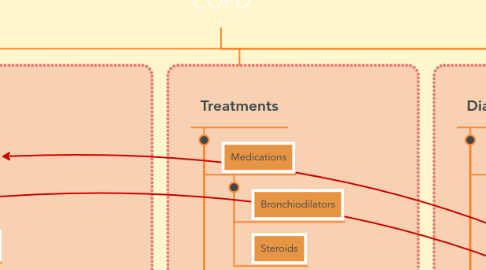
1. Work cited
1.1. Terzikhan, Natalie, et al. “Prevalence and incidence of COPD in smokers and non-Smokers: the Rotterdam Study.” European Journal of Epidemiology , vol. 31, no. 8, 2016, pp. 785–792.
1.2. “COPD Statistics Across America.” COPD Statistics Across America | COPD Foundation, www.copdfoundation.org/What-is-COPD/COPD-Facts/Statistics.aspx. Accessed 29 Sept. 2017.
1.3. Team, Healthline Editorial, and James Rol. “COPD: Tests and Diagnosis.” Healthline, Healthline Media, 2 June 2017, www.healthline.com/health/copd/tests-diagnosis#blood-tests4. Accessed 29 Sept. 2017.
1.4. American Lung Association. “Trends in COPD (Chronic Bronchitis and Emphysema): Morbidity and Mortality.” 2016, pp. 1–23.,
1.5. “Diagnosis.” National Heart Lung and Blood Institute, U.S. Department of Health and Human Services, 28 Apr. 2017, www.nhlbi.nih.gov/health/health-topics/topics/copd/diagnosis. Accessed 29 Sept. 2017.
2. S/SX
2.1. Shortness of breath
2.2. Wheezing
2.3. Tightness in your chest
2.4. Long term or chronic cough that produces mucous
2.5. Blueness of lips or fingernail bed
2.6. Frequent respiratory infection
2.7. Lack of energy
2.8. Unintended weight loss
2.9. Swelling in ankles feet or legs
3. Treatments
3.1. Medications
3.1.1. Bronchiodilators
3.1.2. Steroids
3.2. Self care
3.2.1. Avoid fumes
3.2.2. Avoid smoking
3.3. Supportive care
3.3.1. Oxygen therapy
3.4. Therapies
3.4.1. Pulmonary rehabilitation
3.5. Specialists
3.5.1. Pulmonologist
3.5.2. Primary care provider (PCP)
4. Diagnostics
4.1. Family history
4.1.1. Genetic predisposition and prevalence
4.2. Physical exam
4.3. Spirometer
4.4. Bronchioreversibility test
4.5. Blood tests
4.6. Genetic testing
4.7. Chest X-ray
4.8. CT scan
4.9. Sputum examination
4.10. EKG
4.11. Misdiagnosis
4.11.1. Can often be misdiagnosed for asthma
4.11.2. Can be misdiagnosed for emphesema
5. Pathogenesis
5.1. Changes in pulmonary vessels
5.1.1. Hyperplasia
5.1.1.1. Proliferation of mesenchymal cells
5.1.1.2. Elastic and collagen deposition
5.1.1.2.1. Increased obstruction
5.1.2. Increased number of inflammatory cells mainly T lymphocytes of adventitious of pulmonary muscular arteries
6. Etiology/risk factors
6.1. Smoking
6.1.1. Cigarettes
6.1.2. Cigars
6.1.3. Pipes
6.2. Age
6.2.1. Most people are 40 years old when symptoms begin
6.2.1.1. If under 40 screenings are routine
6.3. Heredity
6.3.1. Homozygosity for the Z allele of alpha 1-antitrypsin gene
6.4. Occupational pollution exposure
6.5. History of childhood respiratory infections
6.6. Environ,metal air pollution
6.6.1. Second hand smoke
6.7. Low socioeconomic status
6.8. Parenchyma destruction (emphysema)
6.9. Obstructive bronchiolitis
6.10. Weather
6.10.1. Winter
6.10.2. Temperature extremes can cause flare ups
6.11. Can cause cancer
6.11.1. Laryngeal cancer
6.11.2. Pharyngeal cancer
6.11.3. Nasal sinus cancer
6.11.4. Brain tumors
6.11.5. Urothelial cancer
6.11.6. Colorectal cancer
6.11.7. Stomach cancers
6.11.8. Breast cancer
